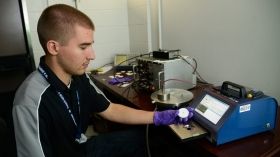“We wanted a rapid way of detecting radiological aerosols that are usually associated with the production of dirty bombs or other radiological weapons,” says Joseph Cope, a Ph.D. student and fellow with the Consortium for Nonproliferation Enabling Capabilities (CNEC) at NC State and lead author of a paper on the work.
At present, emergency responders who are characterizing potential radiological risk need to take an air sample and ship it to a radiochemistry lab after preliminary screening analysis. The process means it can take days or weeks to get quality results that authorities can use to make informed decisions.
“We’ve found a way that repurposes existing tools, and can give first responders quality information in as little as two hours,” Cope says.
Continue reading at North Carolina State University
Image via North Carolina State University


